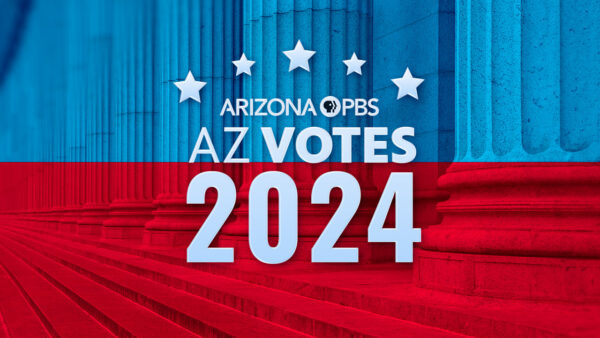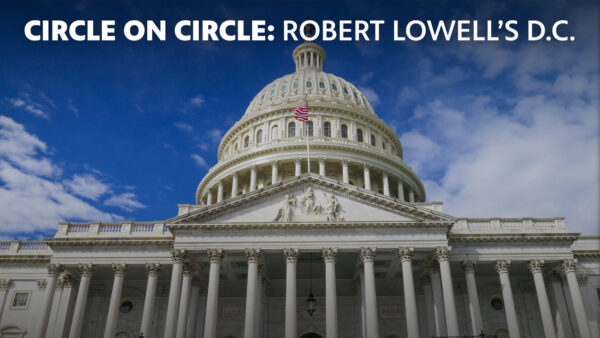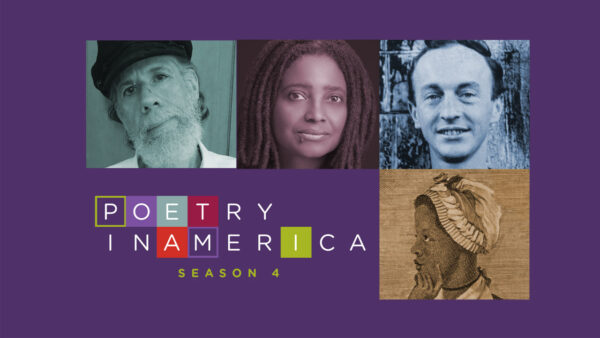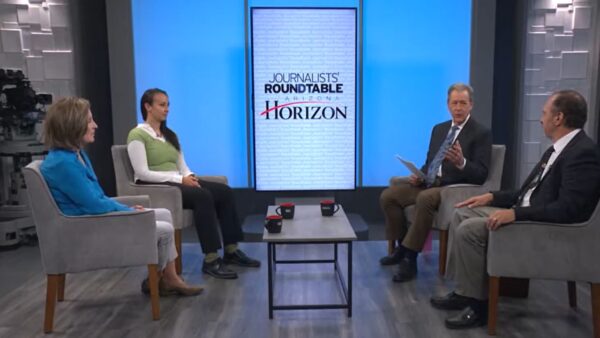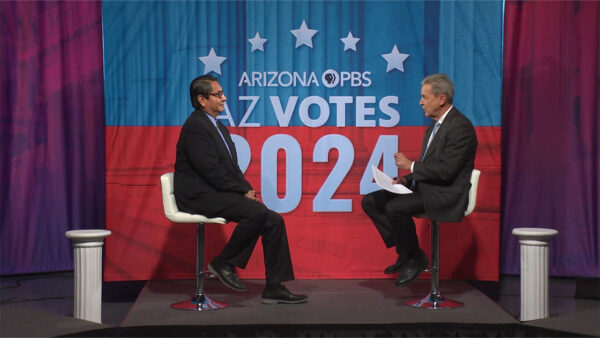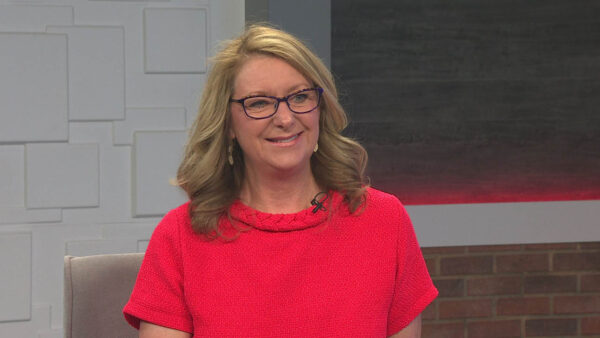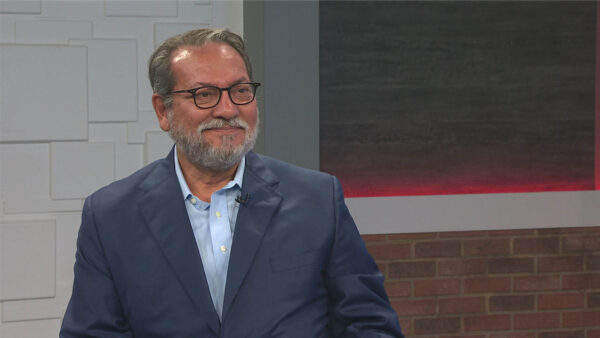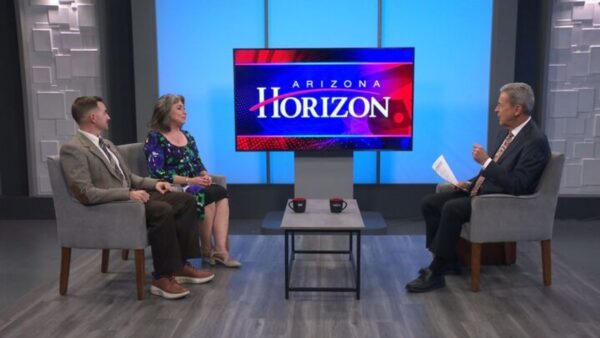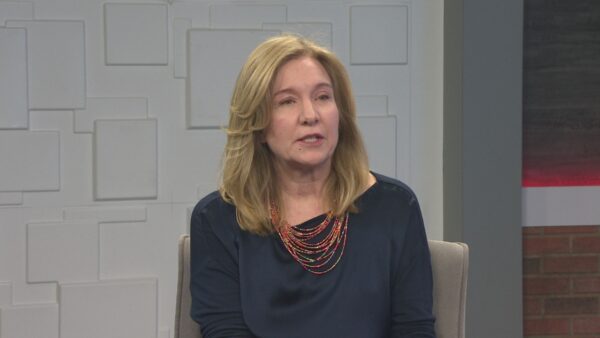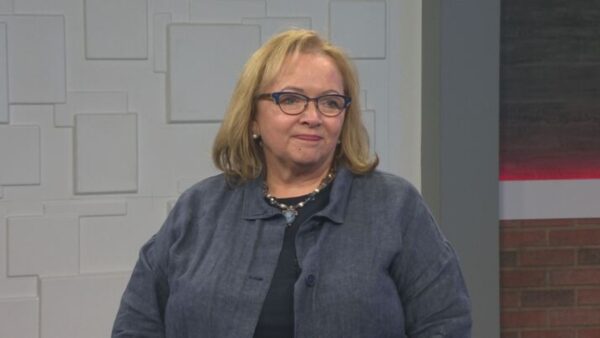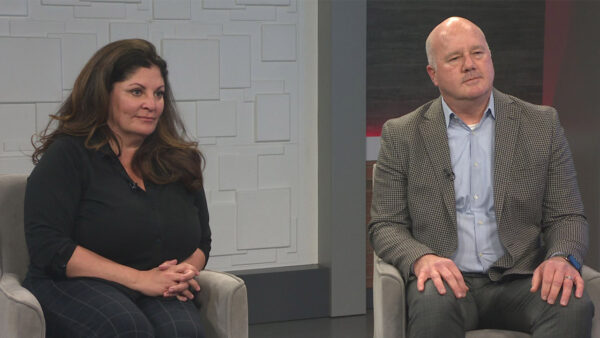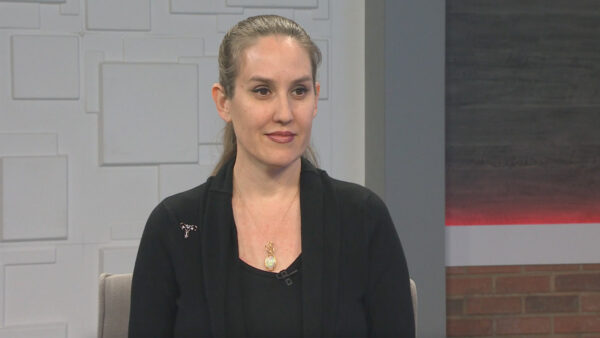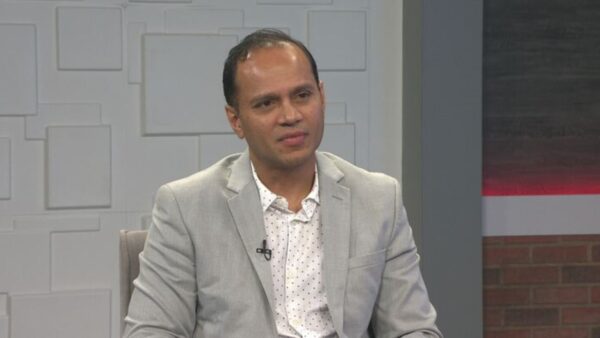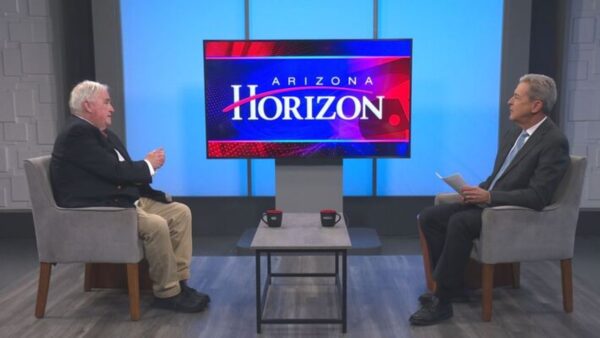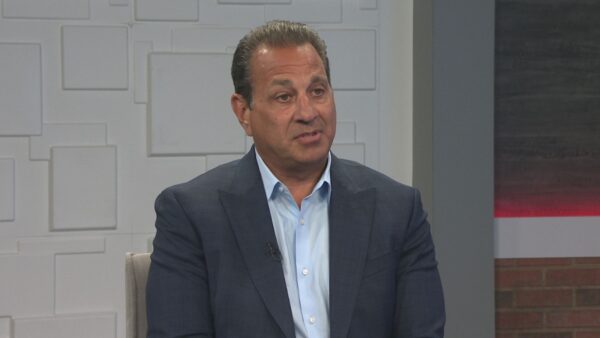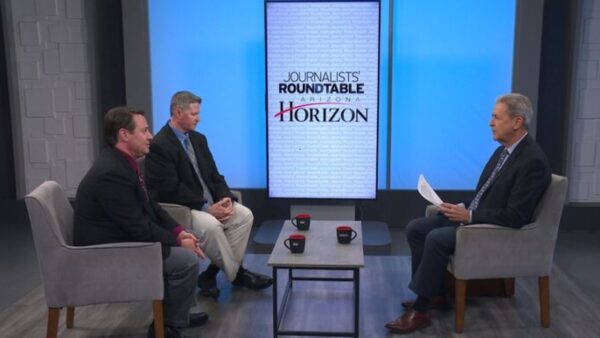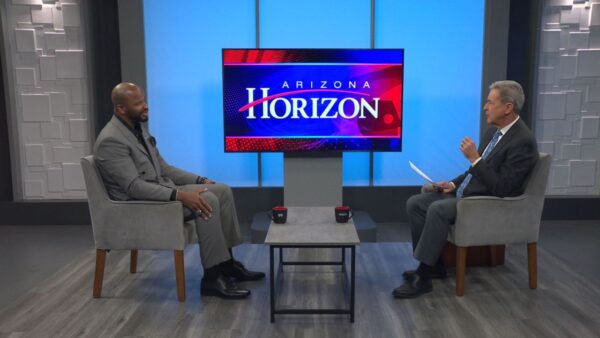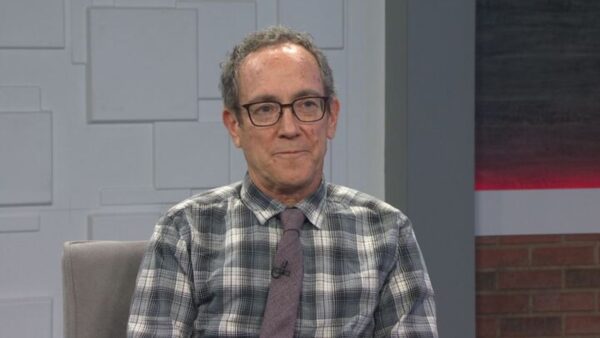As more and more states legalize recreational use of marijuana, AAA will be releasing a study on how cannabis affects drivers who have been using the drug. AAA also will have recommendations for comprehensive enforcement to address marijuana use.
Ted Simons: Good evening. Welcome to "Arizona Horizon." I'm Ted Simons. Governor Ducey said signed into law the state budget passed by the legislature last week. The $9.6 billion plan is structurally balanced for the first time in year, delays policy changes that would have led to over $30 million in K-12 education. The state's universities will receive an additional $32 million, there's money for child safety and foster care and there are tax cuts. The governor signed a firearms bill that ensures people can carry concealed weapons on public streets and near school grounds. Now the governor did veto a measure that would have involved Arizona in an interstate compact that agreed to nullify laws that target the second amendment. The governor also rejected a bill that would have given developers the right to issue bonds and levy taxes to pay for public infrastructure. Last night we heard from a supporter of proposition 123, which boosts education funding by increasing distribution from the state's land trust. Tonight we hear from the other side. Joining is is Shirley Sandelands, president of the Arizona league of women voters which opposes prop 123. Welcome to "Arizona Horizon."
Shirley Sandelands: Thank you.
Ted Simons: Why are you opposed to prop 123?
Shirley Sandelands: The league of women voters opposes it because the governor and legislature have not been following the law. They have not been following the 2301 proposition, which did increase inflationary funding to schools and reset the formula for schools and added a .6 sales tax to add inflationary payment, and in 2010 and after the legislature stopped funding the schools according to that law, so they didn't fund the schools, they did not obey the law. If I don't pay my taxes, and I don't obey the law, I cannot do that. So the legislature has done this, and consequently they were sued and the Supreme Court of Arizona said they should follow the law. They have not done that. Therefore, evidently the governor thinks you can make a compromise, get people together, both sides of the lawsuit, and come up with something that but the something is only about 70% of what they should be doing anyway.
Ted Simons: You mentioned the lawsuit. The plaintiffs in that lawsuit did sign on to this settlement and it is a compromise. It's not perfect, but some would suggest it's as close to a perfect compromise, supporters say this, as you can get. In a compromise do you get what you can get and move on like so many education officials throughout the day are saying? They agree with this.
Shirley Sandelands: I understand what you're saying but I'm going to go back to the initiative. The League of Women Voters wonders are we now going to throw out all initiatives good the legislature doesn't like them and they will try to get a compromise? We stand for voters' rights and for the voters of Arizona having initiatives as is in the constitution. Thus we don't see that we're protecting our constitution, our voters' rights, by going along with this. I know the schools are desperate. I know they need money. They should have been funded. The state had the money to fund it. The Supreme Court said they should do it. But the legislature is not doing it. An individual cannot get away with disobeying the law without consequences. But the legislature has gotten away with it and the governor currently has gotten away with it. To us, we like to protect what has happened with having initiatives in Arizona. We have an independent redistricting commission as a result, clean elections as a result, and we actually as League of Women Voters support this kind of democracy.
Ted Simons: Okay. We hear that and we understand the principle, but what are the alternatives? Let's say you win and proposition 123 is voted down. What happens next?
Shirley Sandelands: well, we still have a treasurer in the state who is against this proposition also. In fact all the past treasurers except for Ducey are against this proposition. I think the treasurer is going to have to again talk with the legislative body and see if they cannot determine that they have to pay.
Ted Simons: but then we get back to the realty of the situation. This is a legislature that was willing to go all the way to a constitutional crisis to avoid paying this money. How in the world are they going to change their mind after proposition 123 is voted down?
Shirley Sandelands: If it's voted down then maybe people of Arizona will vote down some of the legislators.
Ted Simons: do you think enough of them will vote them down?
Shirley Sandelands: I have no way of knowing. What I do know is that the supporters have over $4 million and they are blanketing the state saying that this is not causing you to have any taxes and this is going to help education. Well, do we know if it's really going to help education? The legislatures are the compromise. They have put in three ways they can stop paying the inflationary fund. They put in safeguards for themselves. Are they going to follow through with this? Why should we trust them since they did not follow through with the other?
Ted Simons: I think a lot of education officials, we had one last night that supports the measure, says it's not perfect but he sees the realty of the situation. For tax increase you need two-thirds of the legislature. You're knot going to get that in the foreseeable future. Even a veto you need three-fourths of the vote. If the lawsuit continues you got three to five years of back and forth, appeals on either side. Meanwhile the education people are saying we'll take 7 cents on the dollar, 70 cents on the dollar right now and we'll move forward from there. Is that a bargain that you just can't make?
Shirley Sandelands: It's not the bargain that we oppose so much, it's the fact that they are not following a voter approved law, and I really don't want to get deeply into the land trust, but part of that money they are saying that they are saving the schools with is money that was going to go anyway to the schools from the land trust. So they are really not adding much more and they are not adding it from the general funds and they could rescind some of these business tax cuts. From what I have seen and read, CEOs of major businesses think education should be improved, so if it should be improved, to bring other businesses to Arizona, it doesn't seem to me that tax cuts are bringing other businesses to Arizona.
Ted Simons: there's a study saying that isn't the case, we're not seeing the kinds of development and growth that we have should seen.
Shirley Sandelands: we need educated people. We need to fund education.
Ted Simons: I think a lot of people would agree with that but again we're looking at political realty to where what you might think is a perfect situation doesn't exist. Do you say, okay, I can't get what I want. But I can find 70% of it and move on?
Shirley Sandelands: I think you have to tell them that they need to follow the law. I think they want to skimp or to get a compromise because they say they can't follow it or they had the money, the court indicated that they have the money. So I think they need to know it would be wonderful if the people of Arizona would say we put this in to help education, and what you're telling us is really a false kind of sham on how you're going to fund education because they now have put in -- they have put some triggers in so who can trust that they will not stop in the future in funding. Education should be the most important that the state legislature does. I think they need to be told that they are not doing it correctly.
Ted Simons: okay. If they get that message and the school districts do not get this money for one, two, three or more years as the fighting continues and the pushing and shoving and fighting and biting continues, you have made your point. Will that point be good for education in Arizona?
Shirley Sandelands: Well, if you say we would make the point, I would think that legislators would see that we have made a point.
Ted Simons: Do you think this --
Shirley Sandelands: I don't know whether any of them will because they seem to be interested in other things. But they actually have a duty to fund properly education, and that is something that we really support. But this is such a crazy kind of compromise. I understand that people are desperate, but I also understand that the government should function the way it's supposed to function. The legislators and governor don't follow the law, but I have to follow the law.
Ted Simons: Last question for you. Would you support legal action if prop 123 passes regarding the enabling act and a whole variety of other aspects?
Shirley Sandelands: I do think there will be legal action but I'm not privy to anything related to it at the moment. But we would have to look at it because, yes, we might be willing to support but I don't see that we would be initiating.
Ted Simons: Very good. Good to have you here. Thanks so much for joining us.
Shirley Sandelands: thank you for asking me.
Ted Simons: Triple-A released a new study today showing fatal accidents spiked after the state of Washington legalized marijuana. It also questions legal limits for marijuana and driving. Here is Linda Gorman of Triple-A Arizona. Good to see you again. Thanks for joining us.
Linda Gorman: Thanks for having me.
Ted Simons: what did this study look at?
Linda Gorman: This is the first study of its kind from Triple-A foundation for safety that looked at the fatal rate of those drivers who had had or recently had marijuana in their system. What we found was that those fatal rates doubled between 2013 to 2014, from 8% to 17%. Now, if you look at all fatal crashes during that time period it was found about one in six drivers were under the influence recently of marijuana.
Ted Simons: when we say recently and under the influence, how recent, how much under, what kind of influence?
Linda Gorman: well, it's a two-part answer. Recurrently would imply tHC is the impairment element in marijuana. There's active tHC, and there's inactive tHC, so active tHC, that indicates typically the person has used marijuana within the last hour or so before driving. This is very recent, before driving. Another point is what we're not saying and what the study isn't saying in terms of limitations we're not saying that the fatality rates spiked because of marijuana use. This is just simply an eye-opening study which we hope to be the first of its kind on further research that's needed.
Ted Simons: Do we know that marijuana actually played a part in these accidents?
Linda Gorman: we believe that they did. Only because if you look we also looked at crashes, they of course rose during that time, and we looked at marijuana usage in general. Before the recreational marijuana was legalized it was about 7.5% of people said they used marijuana. Afterwards that spiked and leveled off to about 10.5%. Even when you take that increase into consideration, even when you take the increase of crashes over all into consideration, we believe that marijuana played a factor but we just don't know how much.
Ted Simons: If more people are using marijuana and there are, you know, accidents, X number of accidents, the idea that more people may have some trace of THC in their seems seems like a corollary there.
Linda Gorman: It is such a complex topic. The interesting thing about marijuana is most people are used to blood-alcohol concentration, alcohol. We have had decades of research in temperatures of how blood-alcohol levels impact driving, how alcohol is absorbed in the body. We don't have that research with marijuana. Quite simply research with marijuana and driving isn't funded. It's an illicit substance until recently and just four states and D.C., so you can't get a research project funded asking drivers to smoke an illegal substance and drive behind the wheel.
Ted Simons: As far as control factors in the study, was alcohol also found? I don't want to get absurd are but were they all lefthanded, driving certain cars?
Linda Gorman: In this particular study it was just marijuana. What we do know generally about marijuana usage that you don't see with alcohol usage is that marijuana users typically also drink. So not necessarily at the same time but they will also admit to drinking alcohol. You don't see the same thing with alcohol. So in a lot of times when there's a crash and they test for what substances were impairing they find the quickest, easiest substance. The vast majority of cases that's alcohol because it's a very easy thing to test for. So in a lot of these impaired crashes across the country frankly the person is probably under one or more impairing substances.
Ted Simons: you mentioned alcohol being an easy thing to test for. Is there a test for marijuana, something blood-alcohol level like that would work? It sounds like from the study you guys aren't all that convinced there's anything that works very well.
Linda Gorman: we do think there is a strategy that would work, but unfortunately the current strategies is not one we recommend based on this research. All states have what's called a per se limit. Some have a specific amount. Arizona has no amount. Arizona is a zero tolerance state. That tests the amount of THC the impaired substance, is allowed in the blood before someone is defined as impaired, however it's not apples to apples when you look at blood-alcohol concentration. There's no scientific evidence that proves a certain amount of THC in the blood equals impairment. Quite frankly, THC is a fat soluble whereas fat is not fat soluble. It depends on the size of the person, how much they smoke, how often they smoke. If you have someone who consumes marijuana on a fairly regular basis they can have THC in their system a low level at all times. In Arizona it's a zero tolerance law. If we find any amount of THC, active or inactive, you can be charged for impairment. That's just not really fair.
Ted Simons: It doesn't sound realistic. Especially if this ever winds up on the ballot and passes. Is there -- how do you accurately articulate some sort of enforce minute procedure for marijuana?
Linda Gorman: well, Triple-A did a lot of research. We talked with prosecutors and law enforcement across the country and found that really a two-pronged approach is the best approach based on research that we have now. One is definitely a test for THC in the system. You at least need to prove that it's present. Along with that you need evidence of impairment that the officer saw in the field. So trained officers are actually a critical component. There's law enforcement training that Arizona is actually a model program for this, by the way, where law enforcement officers can go through and become drug recognition experts. They are called DREs. They can test for a variety of impaired substances, opioids, cocaine, marijuana. That testimony along with the evidence, the blood evidence, is the way to accurately articulate impairment once that person is charged.
Ted Simons: so you have objective numbers and subjective feel from the officer.
Linda Gorman: yes.
Ted Simons: last question on this. I'll have people tell me sounds like Triple-A is against the legalization of marijuana because of this study.
Linda Gorman: that's not the case. We actually have no position on marijuana just as we don't have a position on alcohol. We just believe if it's legalized that we should be able to track it and we should be able to accurately assess impairment. It's unfair right now on both sides. You have people being wrongly convicted who are not actually impaired then people who are going free who were impaired based on the limits across the country. So we just want to see enforcement that's fair and accurate.
Ted Simons: and bottom line that's what you take from this particular study, find out the best way to use enforcement and be ready for it when the situation arises, which in Arizona could be later this year.
Linda Gorman: you're talking about a potential law change as well as a change in the way we track traffic crashes. Right now we only track alcohol and we lump dunk driving together. If we're going to legalize marijuana we should be tracking marijuana and marijuana.
Ted Simons: Good to have you here.
Video: Introducing classical Arizona PBS, your classical music connection. On TV listen to classical Arizona PBS on digital channel 8.4. On the go download the app to stream performances. Find out about classical concerts and watch exclusive video. Download the app then follow classical Arizona PBS on Facebook and twitter for news, photos and events near you. Classical Arizona PBS, your classical music connection.
Ted Simons: when you weigh 1,000 pounds and are on your feet, all four of them, over 20 hours a day your shoes matter. That's why farriers, the men and women who shoe horses are so important. A bad shoe can do serious physical damage to a horse. Photojournalist Langston Fields and producer Allysa Adams spent the day with a farrier on a mission to create a custom fit for every hoof he encounters.
Video: My name is Jeremiah Harris. My business is hoof and forge. We had horses growing up, and started working with our farrier when I was 13 years old. I love everything about it. I think there's a connection that we have with horses that a lot of people have, they have been in our life and civilization for such a long time. And you get to use your brain. It's very scientific. People call it an art and a science. I always tell people I have been putting shoes on horses for 18 years but only the last seven to ten years that I have got a true appreciation, made it a skilled trade and really realized what I'm doing. Each shoe is custom made. Every sipping will time for the horse as opposed to buying a store bought shoe. To get the proper fit there's an equation you use. Couple different methods to measure the foot so I know how much steel to cut to make that fit just right for him. Good boy. I know. I think if you respect them as creature, I feel like we offer or ask a lot out of them in order to do what we do as farriers, and to just manhandle them is a lot to ask. I try to be as polite as possible to them. [laughter] They generally return the favor. Shoe selection, what type of shoe you're going to use is also important. These are things an experienced farrier will be better be able to serve your horse. There's a term you hear a lot in farrierring, balancing to the foot balance. You have pitch, roll and yaw, right, just like a plane, and roll is to make sure you're sighting it perpendicular, that the foot is underneath the horse. Because if a horse can tolerate a little imbalance but over time if chronic it can lead to a lot of different types of injuries. You don't want to think of the shoe as an apparatus but you want to think of it as an extension of the hoof, so just as an athlete wears custom fit cleats, you want the same thing for a horse. You want them to feel as if they really don't have anything at all, that it's just an extension of their hoof. Every hammer blow that I do, every time that I'm reshaping or changing this shoe I'm thinking the shape of his foot. So the shape of the outside heel is going to be different than the shape of the inside heel. This is actually all epidermal hoof wall so they don't feel it, like our hair or fingernails. Just like you can burn your nails or burn your hair, you don't feel it, if you left it on too long you would or if I trimmed it down too much -- good boy, Harry. Then they would feel it. A lot of little details go into proper shoeing. Where I choose to put each nail is a conscious decision as I learned from farriers and gained more experience you realize that there's a reason that you do everything, and it's very, very methodical. Even though every horse is different you are able to use certain equations, certain guidelines to make those adjustments. That being said, curvature, having a more artistic eye certainly is helpful. a it's a career. It's a passion. It's a love. It's everything those things combined, the enact we do get compensation monetarily is great, but the fact that what we do is extremely important, so if you don't have a good farrier you're probably not going to have a good foot which means you probably aren't going to have a good horse. It starts with the farrier and everything goes from there.
Ted Simons: Farriers do not have to be licensed but if you're looking he suggests you find someone certified from a farrier organization. Wednesday it's time again for our favorite physicist Lawrence Krauss with the latest science news including the discovery of a moon orbiting a dwarf planet at the edge of our solar system. That's on our next "Arizona Horizon." I'm Ted Simons. Thanks for joining us. You have a great evening.
Video: "Arizona Horizon" is made possible by contributions from the friends of Arizona PBS, members of your PBS station. Thank you.
